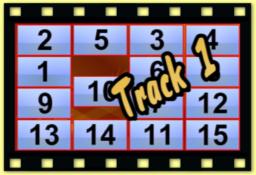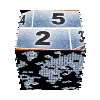| 
There are 16 pieces in my puzzle. So, I took the opportunity to build a triple track montage. It can, for example, be used to animate a slide show!
This theme is stretchable (you may stretch the three themes of the same duration to keep movements synchronized!) to adjust its length as neede more ... |
| | 
Like theme 164, here is a transition between 2 clips using the puzzle arrangement. Each of the 16 parts of the puzzle will make their individual transition during one of their movements with a fade that make them quite 'invisible'. At the end of the montage theme, you will see the Ending more ... |
|
| 
This theme uses the principle of the puzzle to unveil an image or movie, like in subject 162.
The image appears splitted in 16 pieces placed in an appropriate order. The puzzle is then solved to gradually unveil the scene.
the motion phase may be stretched using studio 14 handles capa more ... |
| | 
the same style as the red donkey theme, here is a variant of teasing around the game. 15 pieces of identical size advantage in moving from 16th on the grid space which is free.
This first theme of teasing about the game depicts a transition between two clips, enriched by 4 other videos. more ... |
|
| 
Here is an ultimate montage theme playing the 81 movements of the optimal solution to the puzzle game of red donkey edited by Martin Gardner in 1964. It sets scene transition between two clips. Each of them are splitted into 10 pieces of the puzzle. Each pieces has its own transition duri more ... |
| | 
This theme plays all the 81 movements of the optimal solution edited by Martin Gardner in 1964. It starts and ends with a fade and is stretchable to adapt its length to your needs (also with Studio 12). Unlike the 161 theme, this theme is using simultaneously 2 tracks, which allows usag more ... |
|
| 
This theme plays all the 81 movements of the optimal solution edited by Martin Gardner in 1964. It starts with a fade, and ends with its unique drop zone. This theme is almost identical to the subject 161, but each of the pieces of the red donkey puzzle are here a piece of the selected d more ... |
| | 
This theme plays all the 81 movements of the optimal solution edited by Martin Gardner in 1964. It starts and ends with a fade and is stretchable to adapt its length to your needs (also with Studio 12).
Personally, I used it to make the background of a Ending generic, thus emphasizing more ... |
|
| 
This theme completes the series of transitions from red donkey initiated with the theme 157 followed by the 158 and 159, with the last twenty movements. It is of course also based on the optimal solution edited by Martin Gardner in 1964 with only 81 moves!
Besides the opening scene more ... |
| | 
This theme is a second transition between two scenes. It continues the solution of the game of red donkey initiated with the theme 157 and 158 continued with the theme for another twenty moves. It is of course also based on the optimal solution edited by Martin Gardner in 1964 only 81 mo more ... |
|
| 
This theme is a transition between two scenes. It continues the solution of the game of red donkey initiated with the theme 157 for another twenty moves. It is of course also based on the optimal solution edited by Martin Gardner in 1964 with only 81moves!
Added to the opening scene more ... |
| | 
Here is the opening theme of this series based on the puzzle of the red donkey, especially on the optimal solution edited by Martin Gardner in 1964 in only 81 moves!
This game aims to get the biggest piece, the red donkey, from left to right. Try it, you'll see that it is very more ... |
|
